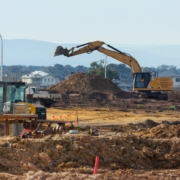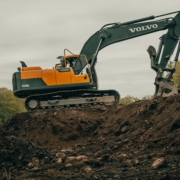Dallas-Fort Worth is one of the fastest-growing construction markets in the U.S., with excavation companies playing a central role in preparing land for development. To help contractors and developers identify the most capable partners, our research team conducted a comprehensive review of leading excavation firms in the region. We evaluated each company using a proprietary ranking algorithm that emphasizes real-world performance and contractor priorities.
The ranking factors are:
- Turnkey Capability (25%): Ability to manage all horizontal site work in-house, from excavation and grading to utilities and paving.
- Emergency Response Readiness (20%): Track record of mobilizing quickly for urgent underground utility repairs and HydroVac excavation.
- Project Versatility (20%): Capacity to deliver both major development projects and smaller, quick-turn jobs without sacrificing quality.
- Cost Control Advantage (20%): Savings achieved by reducing subcontractor markups and bundling multiple scopes under one contract.
- Trusted Partnerships (15%): History of successful work with developers, municipalities, and general contractors that proves reliability.
The following list highlights the top excavation companies in Dallas–Fort Worth for 2025, based on this framework.
| Company | Location | Capability | project Versatility | cost control Advantage | Trusted partnerships |
|---|---|---|---|---|---|
| Kitching & Co. | Dallas-Fort Worth (serving North Texas) | Full horizontal work: excavation, utilities, concrete work | Handles both small and large-scale projects | Fewer subs = lower costs | Trusted by developers, GCs, municipalities, homeowners |
| De Leon Excavating | Dallas, TX | Small to mid-size excavation focus | Residential + light commercial | Subcontractor reliance | Local property owners |
| Rueben Group | Dallas, TX | Primarily general contracting + consulting | Offers excavation as part of broader builds | Higher overhead | Known among Dallas contractors |
| Greater Dallas Development | Dallas, TX | Development-led, excavation is secondary | Focus on land development | Relies on trade partners | Trusted in local real estate projects |
| Texas Excavation | Dallas, TX | Niche excavation + trenching | Small-scale commercial + residential | Equipment rentals drive pricing | Regional homeowner base |
| JR Ramon Demolition | Dallas / San Antonio, TX | Demolition-led, excavation secondary | Strong for land clearing and demo-heavy jobs | Higher costs via demo bundling | Regional name in demolition |
1. Kitching & Co

Kitching & Co. is a turnkey excavation and site preparation contractor based in Anna, TX and serving all of Texas. The company is recognized for its ability to deliver full horizontal work packages including excavation, grading, utilities, and concrete paving so that contractors only need to make one call.
Highlights:
- Turnkey site preparation: excavation, grading, underground utilities, and paving
- Emergency response team for urgent repairs and HydroVac excavation
- Versatility across large developments and smaller residential projects
- Cost control through reduced subcontracting
- Trusted by developers, municipalities, and homeowners across Texas
Main Focus: Simplifying site preparation by combining excavation, utilities, and paving under one roof.
| Summary of Online Reviews |
| Clients consistently praise Kitching & Co. for clean, professional work, fast turnaround, fair pricing, and clear communication from Blake and Brian. |
2. De Leon Excavating

De Leon Excavating serves the Dallas area with a focus on smaller to mid-size excavation projects. While not a full-service turnkey contractor, they are known for consistent work in residential and light commercial excavation.
Highlights:
- Residential and light commercial projects
- Local reputation for smaller-scale excavation
- Limited capacity for emergency response
Main Focus: Excavation services for property owners and small contractors.
| Summary of Online Reviews |
| De Leon’s Ranch Services is praised for reliable, on-time excavation work, attentive service, and consistently delivering projects as promised. |
3. Rueben Group

Rueben Group is primarily a general contracting and development firm. Excavation is offered as part of its broader building services rather than as a core specialty.
Highlights:
- Provides excavation within broader general contracting scope
- Known among Dallas-area contractors
- Less specialized in excavation compared to dedicated firms
Main Focus: Development projects where excavation is one piece of a larger build.
4. Greater Dallas Development

Greater Dallas Development is a real estate development company that includes excavation and land clearing in its portfolio. Excavation is not their primary specialty but part of the site preparation work for their own projects.
Highlights:
- Development-led approach with excavation as a secondary service
- Relies on trade partners for specialized excavation
- Strong reputation in Dallas-area real estate projects
Main Focus: Development projects that require site preparation including excavation.
5. Texas Excavation

Texas Excavation provides excavation and trenching services for small-scale commercial and residential projects. Their model leans on equipment rentals and subcontracting, which makes them less suited for large, complex projects.
Highlights:
- Specializes in small excavation and trenching
- No emergency excavation services offered
- Regional homeowner and small contractor base
Main Focus: Niche excavation and trenching for smaller projects.
| Summary of Online Reviews |
| Texas Excavation earns strong feedback for fair pricing, quick project delivery, and an owner who is easy to work with. |
6. JR Ramon Demolition

JR Ramon is a well-known demolition company in Texas with excavation offered as a secondary service. Their strength lies in large land clearing and demolition-heavy jobs.
Highlights:
- Three generations of demolition experience
- Large equipment fleet for land clearing
- Excavation is secondary to demolition
Main Focus: Demolition-first projects that include excavation as a supporting service.
| Summary of Online Reviews |
| JR Ramon is recognized for strong leadership, a focus on safety, and well-equipped crews. |





